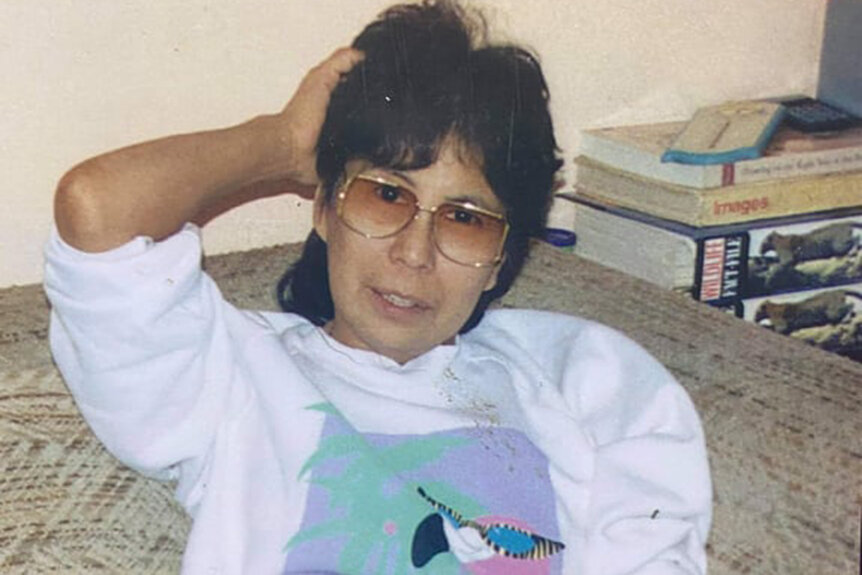Create a free profile to get unlimited access to exclusive videos, breaking news, sweepstakes, and more!
Little-Known Technique With Superglue Helps Solve Brutal Murder Of Alaskan Woman
In August 1996, Martha Hansen was found dead. Surveillance footage from a local bar and a unique fingerprinting technique helped pinpoint her killer.
Martha Hansen was a loving mother who was known to look out for other people in her community. Tragically, her life was cut short by someone the family considered a friend.
On August 8, 1996, authorities were notified that a woman had been found deceased in downtown Anchorage, Alaska. A city electrician found Hansen's body, lying on a hillside. She was naked except for one white sock on her foot. Her other clothes were lying nearby.
She had signs of blunt force and sexual and was strangled to death.
"I dont think I remember the exact words because from that day on I blocked things out," daughter Tina Stephan told "Fatal Frontier: Evil In Alaska," airing Sundays at 7/6c and 8/7c on Oxygen.
Martha Hansen was a 46-year-old mother of four. "She loved people and she trusted them. She'd do anything she could do to help you. She'd never turn someone away — she just didn’t have it in her," her ex-husband Dave Hansen told producers.
But Martha had dealt with numerous tragedies. During the 1970s, she lost three sisters and a husband during a short period. The losses affected her greatly, and she sometimes drank too much, much to the chagrin of her new husband, Dave.
"She could take off and be gone four or five days even. I was worried sick she'd be hurt or killed. We got divorced," Dave explained.
After the divorce, she and her children moved away from Tyonek, the small native village where she had grown up, to Anchorage, to get away from the drinking scene in the village, her daughter told producers.
Investigators scoured the crime scene for evidence. They found foot impressions as well as long human hairs tangled in nearby nearby trees. There were also depressions indicating that someone had sat by her body. It appeared the killer had tried to burn her hair.
"There was substantial postmortem activity. Somebody spent some time with her after they killed her," Michael Grimes, a retired sergeant with Anchorage PD, told producers.
Bill Gifford, who was captain of Anchorage PD at the time, came up with an interesting idea based off a case he had read about.
"If the conditions are just right, Superglue could raise a print on the body ... you set up a tight ... heat the liquid glue and as it heats, it starts putting vapors, then you push those vapors over the body you’re trying to get the print off of. You’re trying to get the glue to adhere to the skin," Gifford explained.
The unusual technique actually worked. They found a clear palm print on her body. "It was the best I've gotten so far," Gifford said.
But palm prints aren't usually taken when someone is arrested, so they didn't find any matches in their database.
"All the forensics in the world don’t mean anything unless you have someone to compare it to," Grimes told producers.
Investigators went to 4th Avenue, as they heard Martha frequented the bars there. They canvassed the area, showing people her photo as well as a drawing of watch she had been wearing and was now missing.
They got a break: an owner of a bar said Martha was there the night before, and offered investigators the surveillance footage from outside the bar. They managed to spot her walking out on the tape.
"She met a Native male who had long waist-length hairs, darker on the top, lighter color in the middle, and lightest on the end. And they interlaced their arms and walked down the street together. This was maybe one of the last people to see Ms. Hansen alive," Leo Brandlen, a retired detective with Anchorage PD, told producers.
Investigators took photo of the surveillance footage and again went back down 4th Avenue. No one seemed to be able to identify the man. But then, two police officers spotted someone they thought actually looked like their suspect.
The man denied being the person on the tape, but then revealed he knew who it was: a young man named Evans Lee Curtis.
Authorities went to the last known address of Evans Lee Curtis. His mother and brother lived there, and said Curtis hadn't lived there in some time. They did provide an address Curtis frequently visited. At this home, they met a man and a woman who said they knew him, but hadn't seen him in awhile.
Not long after, the 16-year-old sister of the girl who lived there called police to report that Curtis had actually been at the residence recently, smoking and drinking with friends. She said he had blood on his clothing at the time, but insisted it was from a fight.
The girl was able to retrieve the bloody clothing, which had been in the laundry room. The blood was found to match Martha's. Investigators also learned Curtis had given the girl a birthday present: a watch identical to the one Martha was missing.
Martha's family was shocked to learn Evans Lee Curtis was the suspect in Martha's murder.
"I was just in disbelief. Evans Lee Curtis was just a family friend. Just somebody we had let into our house. This young kid same age as me," Stephan said.
Curtis was eventually located and brought in for questioning. The trailer he had last been staying at was searched, and more bloodstained clothing was found. His palm print was also taken: it was a match to the one found on Martha Hansen's body.
Evans Lee Curtis was arrested and charged with murder.
Investigators believe Martha ran into him while she was out drinking, and he invited her to come have a bottle in the woods with him. There, they think he made sexual advances — and when she resisted, he killed her.
Curtis pleaded no contest to first-degree murder and was sentenced to 99 years in prison.
For more on this case, watch "Fatal Frontier: Evil In Alaska," airing Sundays at 7/6c and 8/7c on Oxygen or stream episodes here.























